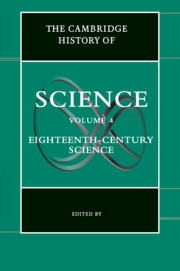Book contents
- Frontmatter
- 1 Introduction
- Part I Science and Society
- Part II Disciplines
- 10 Classifying the Sciences
- 11 Philosophy of Science
- 12 Ideas of Nature: Natural Philosophy
- 13 Mathematics
- 14 Astronomy and Cosmology
- 15 Mechanics and Experimental Physics
- 16 Chemistry
- 17 The Life Sciences
- 18 The Earth Sciences
- 19 The Human Sciences
- 20 The Medical Sciences
- 21 Marginalized Practices
- Part III Special Themes
- Part IV Non-Western Traditions
- Part V Ramifications and Impacts
- Index
- References
21 - Marginalized Practices
from Part II - Disciplines
Published online by Cambridge University Press: 28 March 2008
- Frontmatter
- 1 Introduction
- Part I Science and Society
- Part II Disciplines
- 10 Classifying the Sciences
- 11 Philosophy of Science
- 12 Ideas of Nature: Natural Philosophy
- 13 Mathematics
- 14 Astronomy and Cosmology
- 15 Mechanics and Experimental Physics
- 16 Chemistry
- 17 The Life Sciences
- 18 The Earth Sciences
- 19 The Human Sciences
- 20 The Medical Sciences
- 21 Marginalized Practices
- Part III Special Themes
- Part IV Non-Western Traditions
- Part V Ramifications and Impacts
- Index
- References
Summary
In August 1783, three eminent men of science made the thirty-mile journey from London to Guildford to watch one of their colleagues, James Price, fulfill the alchemists’ ancient dream of extracting gold from mercury. This distinguished chemist, a wealthy Oxford graduate who had been elected to the Royal Society when only twenty-nine years old, had already publicly demonstrated his alchemical skills and had published a book advertising his successful transmutations. Concerned to preserve the Royal Society’s reputation, its President, Joseph Banks, instructed Price to repeat his experiments before an expert audience. But instead of the process of lucrative creation they had been promised, Banks’s delegates witnessed only one of self-destruction, as Price swallowed a glass of laurel water and died in front of their eyes. Price was pushed into making this ultimate sacrifice in the cause of Enlightenment rationality. Some of his critical peers were preoccupied less with the validity of his claims than with the threat his activities posed to the status of established institutions. One of Banks’s confidants, Charles Blagden, articulated this interest in guarding the proprieties of scientific behavior rather than monitoring its results:
Was ever any country more completely disgraced than ours has been by the conduct of the University. For, granting that Price has made the discovery held out in his book, should it not have been said to him that the man who having hit upon an improvement in science, keeps it from the world deserves rather to be excluded from the Society of learned men than to be adorned with extraordinary academic honours?
Information
- Type
- Chapter
- Information
- The Cambridge History of Science , pp. 485 - 508Publisher: Cambridge University PressPrint publication year: 2003
References
Accessibility standard: Unknown
- 5
- Cited by
